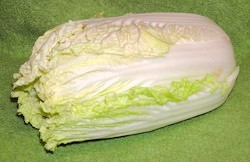Chinese cabbage facts for kids
Quick facts for kids Chinese cabbage |
|
|---|---|
| Species | Brassica rapa |
| Cultivar group | Chinensis Group, Pekinensis Group |
| Origin | China, before the 15th century |
| Cultivar group members | Many; see text |
Chinese cabbage is a leafy green vegetable. It comes from the plant species Brassica rapa. There are two main types of Chinese cabbage. These are the Pekinensis Group, known as napa cabbage, and the Chinensis Group, known as bok choy. Both are very popular in Chinese cooking.
These vegetables are types of turnips. They belong to the same plant family as other common vegetables. These include cabbage, broccoli, and cauliflower. Both napa cabbage and bok choy have many different names and spellings.
Contents
The Story of Chinese Cabbage
Chinese cabbage was first grown in the Yangtze River area of China. This was a long time ago. During the Ming Dynasty, a famous scientist named Li Shizhen helped make it popular. He wrote about its healthy qualities.
Around the 14th century, a type of Chinese cabbage from the Zhejiang area moved north. Soon, more napa cabbage was grown in northern China than in the south. This cabbage was then sent back south along the Grand Canal. It was also traded by sea to places like Guangdong.
Napa cabbage became a key food in Northeastern Chinese cuisine. People used it to make suan cai, which is like Chinese sauerkraut. In Korea, this idea led to the creation of kimchi. Today, you can find Chinese cabbage in markets all over the world. It's popular with Chinese people living abroad. It's also liked in colder places because it can grow well in cool weather.
In 2017, something cool happened! Astronauts on the International Space Station grew Chinese cabbage. They ate some of it, and the rest was saved for science experiments.
Different Kinds of Chinese Cabbage
There are two main groups of Brassica rapa that people use as leafy vegetables in China. Each group has many different types.
Pekinensis Group: Napa Cabbage
This group is the most common type of Chinese cabbage. You'll see it often, especially outside of Asia. Names like napa cabbage, dà báicài (meaning "large white vegetable"), and hakusai usually refer to this group.
Napa cabbage has wide green leaves. Its stems are white. The leaves are tightly wrapped together. They form a compact, cylinder-shaped head. This type of cabbage is very popular in northern China, especially around Beijing.
Chinensis Group: Bok Choy
Bok choy is part of the Chinensis Group. These types of cabbage do not form a tight head. Instead, they have smooth, dark green leaves. These leaves grow in a loose bunch, similar to celery.
Bok choy is popular in southern China and Southeast Asia. It can also grow well in cold weather. Because of this, it is now grown more and more in Northern Europe.



